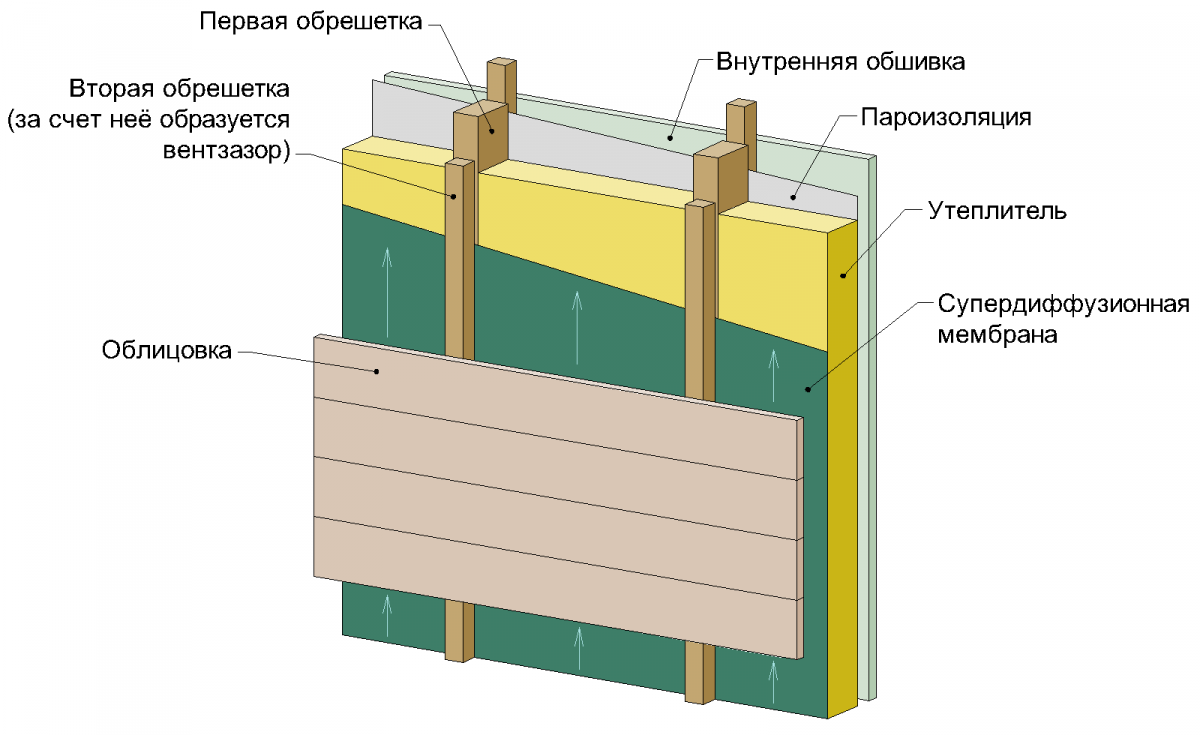The timber, due to its affordable cost, durability and strength, has become a popular material in the construction of houses. Natural wood creates a healthy indoor climate and good vapor permeability. Low thermal conductivity is one of the advantages of timber, but insufficient wall thickness causes high heating costs.
Even with careful joining, gaps remain between the lumber, allowing cold and draft into the room. You can change the situation by insulating a log house. The process of thermal insulation of a wooden building is distinguished by the availability of technology, so it can really be done by hand.
Why is it preferable to place the insulation outside?
External thermal insulation of a log house has its advantages:
- reduced heating costs;
- protection of hygroscopic wooden walls from moisture;
- the appearance of the facade changes according to the individual preferences of the owners;
- the area of the internal space does not decrease.
Criteria for the selection of thermal insulation material
When choosing a heater, you should pay attention to its characteristics: elasticity, resistance to combustion and moisture, thermal conductivity, air permeability. The thickness of the effective layer depends on the temperature in the region and the parameters of the bar. In temperate climates, 50 mm of heat-insulating material is sufficient, and in winter frosts below -20 degrees, this figure doubles. The complexity of installation should also be taken into account, because the work is done by hand.
Insulation methods, what to choose for walls from a bar
Exterior decoration of a log house is carried out in three ways:
- Ventilated facade construction.
The hinged structure includes a wooden lathing, insulation and external cladding made of lining, siding or porcelain stoneware. Do-it-yourself facade installation gives the walls additional heat and sound insulation and brings the dew point out. The structure is easily assembled and lasts up to 50 years.
- Hermetically sealed with polyurethane foam.
Polymer spraying creates a monolithic seamless surface and strengthens the timber walls. The work is carried out using a high pressure washer. It mixes the two components and feeds the compound through a gun to the surface to be insulated. Condensation does not collect under the polymer layer, it does not burn, does not rot, and reduces the noise level. After spraying with polyurethane foam, finishing with a facade material is required. The main disadvantage of this method of insulation is the high price.
- Use of foam boards.
The low cost of the material makes it the most affordable insulation. It is resistant to fluctuations in temperature and humidity, but has a significant drawback - it supports combustion. Fixing the foam on the walls is done with a special glue. Before the installation of the first row, a starting profile is nailed to limit material slippage.
After analyzing the pros and cons of the ways in which you can insulate a log house from the outside, most owners stop at a ventilated facade.
![]()
Practical insulation for a wooden house
Mineral wool will be the best choice for home insulation. It is made from slag, rocks or glass and therefore does not support combustion. The material is easy to fit with your own hands, retains heat well and is affordable.
How to properly assemble a ventilated facade
The technology for the correct installation of a curtain wall includes several stages:
- fastening the lathing;
- laying insulation;
- installation of a diffuse membrane;
- fixation of decorative coating.
Work begins with the application of an antiseptic layer to the timber that protects against decay and moisture. A frame made of wooden planks is stuffed onto the finished surface. The step of the vertical lathing is 1.5 cm less than the width of the insulation. This will allow the material to fit tightly, avoiding crevices and cold bridges.
The bars are attached to the wall with self-tapping screws, their vertical plane is set using a level with a plumb line. Mineral wool mats are inserted between the frame slats, pressed tightly and fixed with umbrella dowels. When a wooden house is located in a region with a low temperature, it will be correct to perform external thermal insulation in two layers.
To protect the insulation from dampness, a special perforated film is laid. It does not allow water to penetrate inside, and releases moisture accumulated in the cotton wool outside. The membrane is laid with an overlap and is fastened with staples, its joints are glued with tape.

The ventilating layer of the façade is created by padding strips over the waterproofing. They provide a space between the insulation and the cladding in which air circulates. The second row of slats becomes the basis for the finishing facade coating. There are ventilation slots in the lower and upper parts of the structure. They are protected from precipitation by special visors.
Mineral wool is an excellent insulation material, but it loses its qualities when wet, so it should be stored indoors. When working with the material, dust and fibers are generated, which cause irritation. Laying mineral wool slabs must be in protective goggles and gloves.
It does not take much time and money to insulate a log house from the outside. The result of quality work will be a comfortable room temperature with lower heating costs.



